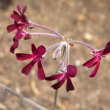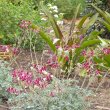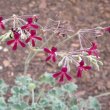| Botanical Name |
Pelargonium sidoides - Hybrid - Plum Pudding |
| Family |
Geraniaceae - The geranium family. |
| Pronunciation |
pe-lar-GO-nee-um sih-DOY-deez |
| Common Name(s) |
|
| Plant Group |
- Ground Cover A plant with a low-growing, spreading habit, grown specifically to cover the ground.
- Perennial A plant whose life cycle lasts for three or more seasons.
|
| Plant Size |
- Small to Medium
| Tree | 8m to 15m |
| Shrub | 75cm to 1m |
| Perennial/ground cover | 20cm to 40cm |
| Bulb | 30cm to 40cm |
| Succulent | 20cm to 40cm |
|
| Position |
- Partial Shade The area is in shade for part of the day and in full sun for part of the day.
- Sun The area is in full sun for all or most of the day, all year round.
|
| General Information |
- Drought Tolerance: High The plant is well adapted to arid conditions; it can survive long periods of drought and high temperatures without extra water.
- Evergreen Plants that have leaves all year round.
- Frost: Half-hardy The plant is able to survive low temperatures and some frost but requires protection against severe frost.
- Sand tolerant Plants adapted to survive in nutrient poor, very sandy soils.
- Water Wise Plant species originating from low rainfall regions that require less water to survive and thrive than other plant species.
- Wind Tolerant Plants able to withstand the effect of strong winds.
|
| Specific Information |
This hybrid of Pelargonium sidoides is in many respects very similar to Pelargonium reniforme, the main difference being in the and colour of the flowers. It forms a low growing rosette with grey-green, crinkled leaves which have well-defined scalloped edges and is visually appealing even when not in flower. The dark wine and magenta flowers contrast vividly with the silvery foliage.
|
| Ad Break |
|
| Flowers |
| Description |
small, delicate pelargonium flowers held in clusters on long, lax stems, above the foliage, but usually somewhat drooping
|
| Season |
- All Year Plants will seldom bloom for the entire season as given in the list, but should flower during a period within these parameters.
- Spring to Summer Plants will seldom bloom for the entire season as given in the list, but should flower during a period within these parameters.
|
| Colour |
|
| Growth Rate |
- Fast Specifying growth rate can be very misleading as there is considerable variation of growth rate depending on type and species of plant, available water, supplementary feeding, mulching and general care, as well as the plants suitability and adaptability to the garden environment.
|
| Plant Uses |
- Attracts bees, butterflies or other insects This plant attracts insects which can be food for birds or other creatures in your garden.
- Border A strip of ground, at the edge of a driveway or path in which ornamental plants or shrubs are planted.
- Container Trees, shrubs and ornamental species that can adapt to growing in a restricted environment.
- Edging A low growing plant that provides softness or definition to the edges of a bed or walkway.
- Filler Either a fast growing tree or shrub used temporarily to fill in an area while the permanent plants grow to a desired size, or a plant used to fill gaps in borders or beds.
- Ground Cover Low-lying plants that spread fast, require minimal maintenance, and cover large expanses or bare areas between bulbs or shrubs. They provide protection from erosion and drought and improve the visual appearance of the garden.
- Interplanting Arranging and planting plants in the garden that have different blooming times and habits of growth, extending the amount of time in which the area is in flower.
- Mass Planting Plants useful for filling a large area with just one or a few kinds of plants spaced close together. Creates a bold, dramatic effect and to reduces maintenance.
- Pot Plant A plant that needs a protected environment on a patio or indoors.
- Rock Garden An area constructed of larger rocks, arranged naturally, to emphasise the use of stones as a main element. Generally plants used do not need a lot of care.
- Stabilize Banks Plant is used to prevent soil erosion because their roots will form a mat that stabilizes the soil and keeps it from washing away in heavy rains.
- Suitable for coastal gardens Plants adapted to dry, sandy soil, forceful wind, limited rainfall and intense sunlight.
- Wild Garden An indigenous garden planted for the benefit of wildlife and birds. Provides food, water, a variety of mini-biomes and no poisonous chemicals are used.
|
| Distribution and Habitat |
|
| Planting Suggestions |
Pelargonium sidoides prefers a full sun position in well drained soil. Avoid over-watering during summer and water only sparingly during wintertime. Deadhead wilted flower stalks on occasion to stimulate a longer flowering period.
In areas with very cold winters they should be kept inside from late autumn to early spring to prevent them from freezing to death.
|
| Lorraine's Garden Notes |
The specimens in my garden, in a mild climate, are in flower for most of the year.
|
| Medicinal Uses |
Hybrid - I have found no data to prove or disprove that the medicinal properties of this hybrid are the same as those of the non-hybrid plant.
|
| Ad Break |
|









Comments
Gardening knowledge
Should I put some smooth gravel under the plant ?
Pelargonium sidoides hybrid
Hi Vasant
This would not be necessary, other than for decorative reasons.
Regards
Lorraine
Pelargonium sidoides plants & seeds
Hi Lorraine,
Do you sell plants and/or seeds for this Pelargonium, and perhaps the reniforme? Can you refer me to a SA nursery or supplier for these plants?
I have a plant in a pot I bought some years ago which I think might be sidoides -- although the flowers are bright magenta... I am attaching two current images; if you can identify it. The poor plant needs some tlc!
I will appreciate your expert opinion.
Regards
Tersia
Pelargonium hybrids
Hi Tersia
Unfortunately your pictures are very small so I can't tell for certain if your plant is Pelargonium sidoides 'Cherry Pudding' or Pelargonium reniforme 'Compact Cerise Pink', but I am pretty sure it is the P. reniforme hybrid.
I do not have the P. reniforme hybrid. I only have the wild reniforme (http://kumbulanursery.co.za/plants/pelargonium-reniforme), P. sidoides hybrid 'Plum Pudding' which is on this page, and the wild P. sidoides (http://kumbulanursery.co.za/plants/pelargonium-sidoides) with the almost black flowers.
If you email me (kumbulanursery@gmail.com) and let me know where you are situated, I will see if I can help you with a supplier.
Kind regards
Lorraine
Discuss this plant
Share knowledge, ask a question or give an experience.